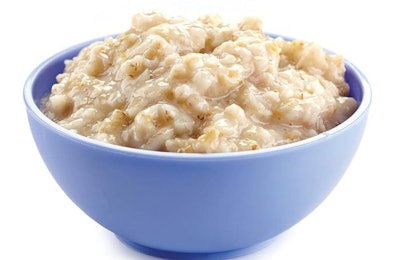
This article appears in the July/August issue of Pig International. View all of the articles in the digital edition of this magazine.
Starch in its natural form exists in granules as a polymer of glucose units, which form essentially linear (amylose) or highly branched (amylopectin) chains. Amylose is amorphous and rather soluble in water, whereas amylopectin is partially crystalline and much less soluble in water.
The ratio of amylopectin to amylose in most cereals is relatively constant at about 4:1. Mutant lines for several cereals exist with almost 100 percent amylopectin (waxy cereals), whereas certain corn mutants have up to 70 percent amylase. Under polarized light, starch granules show birefringence, which appears as a “Maltese cross” over a round black background, due to the high degree of crystallinity in amylopectin. The starch granule as a whole is about 30 percent crystalline and absorbs about 30 percent water under room temperature.
What happens when starch is cooked?
The above holds true for raw starch. When starch is heated with water (e.g., during extrusion), the granule absorbs water and slightly swells. When temperature exceeds a certain degree (around 60C), amylose starts to solubilize and leak out of the granule, whereas the granule starts to lose its birefringence properties because amylopectin is distorted. When 98 percent of birefringence is lost, starch reaches complete gelatinization. Continued heating with excess water causes more amylose, and even amylopectin, to leach, and increases viscosity of solubilized starch until the whole granule is completely soluble at 120C. Degree of solubilization and gelatinization depends on final temperature at which starch is exposed and not on time of holding at a specific temperature.
When starch is heated with limited water (e.g., during pelleting), swelling and distortion of starch granules are limited. The amount of available water affects the degree of completion of the gelatinization process at a given temperature, but it does not affect the temperature at which starch starts to gelatinize. Excessive heating causes amylopectin to leach. When starch is heated without water (e.g., roasting), starch quickly reacts with water naturally present in ingredients. Hydrolysis of starch produces dextrins, which are shorter chains of glucose readily digestible by digestive enzymes (isomaltases).
Starch from different cereals starts to gelatinize at different temperatures, with granule size having a partial effect; small granules generally require less heating to solubilize. Starch from wheat, barley, rye and triticale loses 50 percent of birefringence at about 53C, whereas starch from corn and sorgum loses 50 percent of birefringence at about 67C. Oat starch requires the lowest temperature (55C) among common cereals to reach 50 percent gelatinization, and rice starch the highest (70C), although both rice and oats have rather small starch granules. To achieve complete loss of birefringence, starch must be heated to the upper temperature of the gelatinization range, which is rather impractical under most commercial conditions as it may decrease protein quality.

Starch from different cereals starts to gelatinize at different temperatures, with granule size having a partial effect.
What is retrogradation?
Loss of crystallinity and other changes in starch characteristics above the point of gelatinization are not reversible. As gelatinized starch begins cooling, solubilized starch chains become less energetic and start to interact with each other forming hydrogen bonds by expelling water. As gelatinized starch ages, chains (and especially amylose) continue to interact to form stronger bonds that eventually lead to formation of crystals (retrogradation). Retrograded starch is less soluble in water and thus less digestible (resistant starch) than raw starch. Amylopectin is more resistant to retrogradation but forms stronger bonds than amylose. Thus, retrogradation is more prominent in high-amylose starches, during prolonged storage, and in starches heated beyond gelatinization. In contrast, in thermally processed waxy cereals retrogradation is extremely low.

This table shows the distribution of resistant versus digestible starch for several cereals.
How to measure gelatinization?
Gelatinization is commercially determined with an enzymatic hydrolysis test measuring release of glucose using alpha-amylase in vitro. Because of the nature of this test, fine grinding that disrupts starch granules and increases solubility appears to increase “gelatinization.” Indeed, finely ground raw cereals are more digestible than coarsely ground raw cereals. Thus, more sophisticated methods are used to accurately assess the effects of thermal processing on starch quality. For example, X-ray diffraction measures crystallinity by distinguishing between ordered and disordered states.
Summing up
In brief, starch gelatinization is beneficial because it increases digestibility. In contrast, overcooking can lead to the opposite result due to excessive retrogradation. Selecting the optimal cooking condition for each cereal is important in securing maximal quality in the finished products, especially as no two cereals are alike.
Read more about the Maillard reaction’s impact on animal nutrition
















